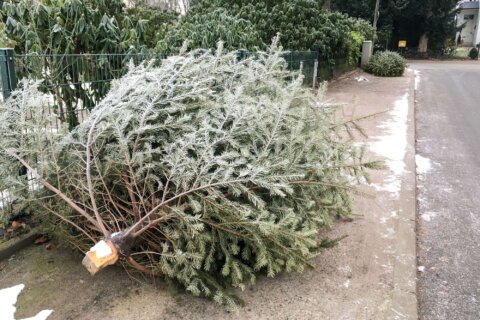The name says it all: stink bug. It’s not exactly the kind of guest you want in your home during the winter.
But because 2020 is apparently the year that keeps on giving, this stink bug season looks like it will be a rough one.
Chris Bergh, entomology professor at the Virginia Agricultural Research and Extension Centers, part of Virginia Tech, told WTOP that researchers noticed the number of brown marmorated stink bugs captured in pheromone-baited traps this year “were much higher than have been in recent years, and this was reported fairly widely throughout the mid-Atlantic region.”
He explained that from roughly September to October, stink bugs outdoors “begin flying in search of somewhere to spend the winter.”
That “somewhere” is often inside homes, especially those located around wooded areas.
“If the stink bugs see your home as being somewhere of interest to them, they tend to fly — often in large numbers — to those locations, and then they find their way in through cracks and crevices and other entry points,” Bergh said. “They’re quite good at accessing those kinds of dark, dry and tight spaces within which they congregate and spend the winter together.”
But homeowners are sometimes hit with a double whammy. The first is the initial infestation when stink bugs enter the home. The second is if they emerge from their “overwintering” (their hibernation state) too early because the site they chose — like an attic — is nice and warm.
“They wake up early,” Bergh said. “And when they do that, we think they follow light and heat downward into the living spaces.”
This can happen throughout the winter months, even lasting into May, when the bugs would normally emerge from hibernation.
“In that sense, a brown marmorated stink bug is a very significant nuisance issue,” Bergh said, adding that researchers don’t understand why some homes attract stink bugs while others don’t.
Bergh said the best option for homeowners is to seal up cracks and crevices, “but again, they’re very adept at finding places to get in.” He doesn’t recommend pesticides because they don’t tend to work on stink bugs.
“You can certainly vacuum them up,” he said, but he warned that this might release their putrid odor.
“They’re called stink bugs for a reason. When they’re excited, they produce a compound that smells very much like strong cilantro,” Bergh said, noting that this is why some people even have dedicated vacuum cleaners to hoover up the bugs.
But stink bugs aren’t just smelly pests. They’re also voracious eaters that pose a major threat to a broad range of plants, from trees to fruit and vegetable crops.
“In the early years of these stink bug invasions — 2010, 2011 and 2012 — growers lost a significant proportion of their harvest … from this pest,” Bergh said.
Interestingly, researchers may have found a natural adversary to combat stink bugs: the samurai wasp.
This small wasp — which is native to Asia, just like the brown marmorated stink bug — was accidentally discovered in 2014 in Beltsville, Maryland.
“And we know that in Asia, the samurai wasp is considered a key natural enemy of brown marmorated stink bugs because the females of that species lay her eggs in the eggs of the brown marmorated stink bug, and her developing larvae feed on and kill the brown marmorated stink bug eggs,” Bergh said, calling the discovery “very exciting.”
Bergh’s lab in Winchester has been redistributing the wasp in spots throughout Virginia, but so far it’s not known how well this strategy will work.
“As time goes by, we learn more and more,” Bergh said, “but we certainly don’t have all the answers at this point.”








